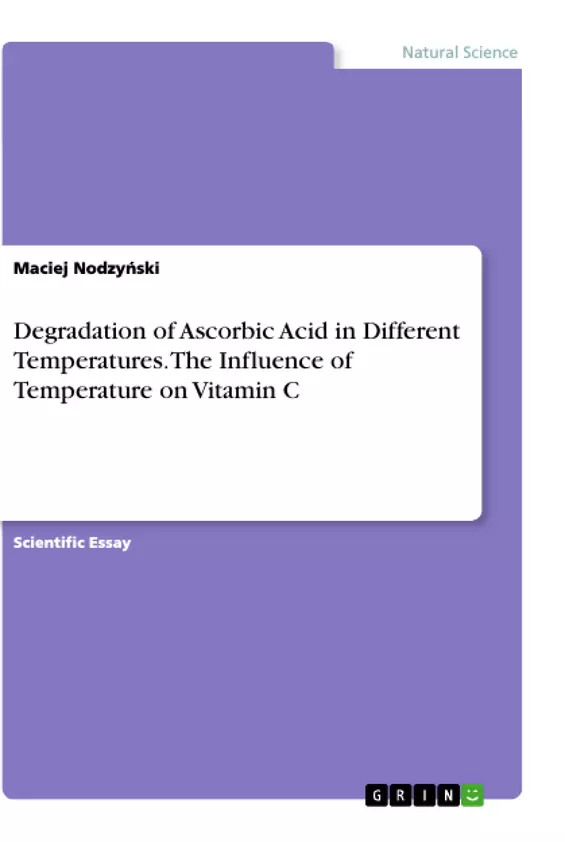This paper aims to investigate how different temperatures influence the degradation of vitamin C as well as to clarify the preconception about this vitamin. More specifically, the relationship between the temperature and the concentration of vitamin C will be researched. The research suggests that vitamin C degrades in elevated temperatures so it is highly probable that it also degrades in hot tea and other hot beverages. Consequently, vitamin C is rather not the component of hot tea with lemon juice that provides curative properties, opposite to what many people believe.
The subject is important because it extends the knowledge about how vitamin C degrades in different temperatures and how to handle this vitamin properly. The research shows at which temperature vitamin C is most effective and this information could be useful for pharmaceutical companies when improving the effectiveness and medicinal properties of drugs where vitamin C is the main constituent. The investigation uses the method of redox titration of vitamin C with iodine solution and the detailed information about this process is presented.
Inhaltsverzeichnis (Table of Contents)
- Introduction
- Research question
- Background information
- Variables
- Investigation
- Equipment
- Preparation of solutions
- Starch indicator
- Vitamin C solution
- Iodine solution
- Procedure
- Risk assessment
Zielsetzung und Themenschwerpunkte (Objectives and Key Themes)
This paper investigates the degradation of vitamin C at different temperatures, specifically focusing on the relationship between temperature and vitamin C concentration. The research aims to clarify misconceptions about the effectiveness of vitamin C in hot beverages, and to provide practical information for pharmaceutical companies regarding the stability and effectiveness of vitamin C-containing drugs.
- Degradation of vitamin C at various temperatures
- Influence of temperature on the concentration of vitamin C
- Misconceptions about the effectiveness of vitamin C in hot beverages
- Practical applications for pharmaceutical companies
- Redox titration as a method for investigating vitamin C degradation
Zusammenfassung der Kapitel (Chapter Summaries)
- Introduction: This chapter introduces the research question and its significance. It discusses the common belief about the effectiveness of vitamin C in hot tea and how this belief contradicts research findings. The importance of investigating vitamin C degradation at elevated temperatures and its implications for pharmaceuticals are highlighted.
- Research question: This chapter formally states the research question, which focuses on how different temperatures influence the degradation pattern of vitamin C over a set time period, using iodometry as the measurement method.
- Background information: This chapter provides detailed information about vitamin C, including its chemical structure, properties, and role in the human body. It explains the sensitivity of vitamin C to temperature and the theoretical basis for its degradation at higher temperatures. The chapter also describes the redox titration method used in the experiment, outlining the chemical reactions involved and the mechanism of the reaction with starch.
- Variables: This chapter defines the independent and dependent variables of the investigation, including the chosen temperature range and the method of measuring vitamin C concentration. It also outlines the control variables, explaining why specific amounts of starch indicator and iodine solution were used, and how pressure and temperature were controlled during the experiment.
- Investigation: This chapter details the experimental setup, including a list of equipment used, the preparation of solutions (starch indicator, vitamin C solution, and iodine solution), and a step-by-step description of the experimental procedure. It also includes a risk assessment section addressing safety, ethical, and environmental considerations related to the experiment.
Schlüsselwörter (Keywords)
This research focuses on the degradation of vitamin C (ascorbic acid) at different temperatures, using iodometry as a method of analysis. Key themes include the influence of temperature on vitamin C concentration, the effectiveness of vitamin C in hot beverages, practical applications for pharmaceuticals, and the chemical reactions involved in redox titration.
- Citation du texte
- Maciej Nodzyński (Auteur), 2021, Degradation of Ascorbic Acid in Different Temperatures. The Influence of Temperature on Vitamin C, Munich, GRIN Verlag, https://www.grin.com/document/1059537



